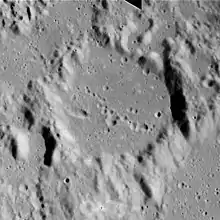
 Apollo 16 image | |
| Coordinates | 7°00′S 13°00′E / 7.0°S 13.0°E |
|---|---|
| Diameter | 32 km |
| Depth | 1.6 km |
| Colongitude | 347° at sunrise |
| Eponym | Eric M. Lindsay |
Lindsay is a small lunar impact crater in the central highlands of the Moon. It was named after the Irish astronomer Eric Mervyn Lindsay.[1] It lies in the irregular terrain to the northwest of the landing site of the Apollo 16 mission. To the south is the crater Anděl, and Taylor is to the east-northeast.
Dr E. J. Öpik stated that this crater was likely formed by the impact of an asteroid about 1 mile (1.6 km) in diameter. The outer rim of this crater is worn and irregular, with incisions along the northern and southern inner walls. There is a cleft in the southeastern rim that links with the slightly larger Dollond B. The interior floor is level and is crossed by a crater chain and a slender cleft at the west end.
This crater was designated Dollond C before being given its current name by the IAU. Dollond itself is located to the south-southeast, due east of Anděl.
References
- ↑ "Lindsay (crater)". Gazetteer of Planetary Nomenclature. USGS Astrogeology Research Program.
- Andersson, L. E.; Whitaker, E. A. (1982). NASA Catalogue of Lunar Nomenclature. NASA RP-1097.
- Bussey, B.; Spudis, P. (2004). The Clementine Atlas of the Moon. New York: Cambridge University Press. ISBN 978-0-521-81528-4.
- Cocks, Elijah E.; Cocks, Josiah C. (1995). Who's Who on the Moon: A Biographical Dictionary of Lunar Nomenclature. Tudor Publishers. ISBN 978-0-936389-27-1.
- McDowell, Jonathan (July 15, 2007). "Lunar Nomenclature". Jonathan's Space Report. Retrieved 2007-10-24.
- Menzel, D. H.; Minnaert, M.; Levin, B.; Dollfus, A.; Bell, B. (1971). "Report on Lunar Nomenclature by the Working Group of Commission 17 of the IAU". Space Science Reviews. 12 (2): 136–186. Bibcode:1971SSRv...12..136M. doi:10.1007/BF00171763. S2CID 122125855.
- Moore, Patrick (2001). On the Moon. Sterling Publishing Co. ISBN 978-0-304-35469-6.
- Price, Fred W. (1988). The Moon Observer's Handbook. Cambridge University Press. ISBN 978-0-521-33500-3.
- Rükl, Antonín (1990). Atlas of the Moon. Kalmbach Books. ISBN 978-0-913135-17-4.
- Webb, Rev. T. W. (1962). Celestial Objects for Common Telescopes (6th revised ed.). Dover. ISBN 978-0-486-20917-3.
- Whitaker, Ewen A. (1999). Mapping and Naming the Moon. Cambridge University Press. ISBN 978-0-521-62248-6.
- Wlasuk, Peter T. (2000). Observing the Moon. Springer. ISBN 978-1-85233-193-1.